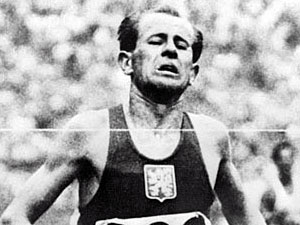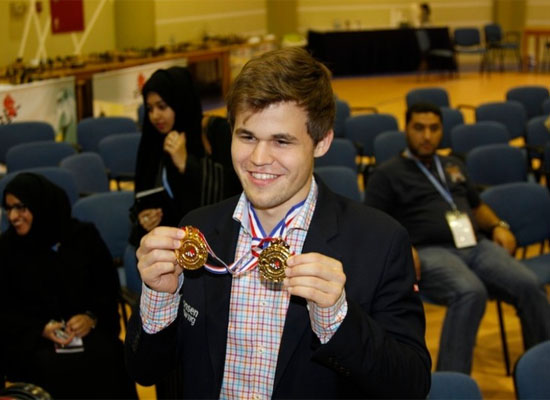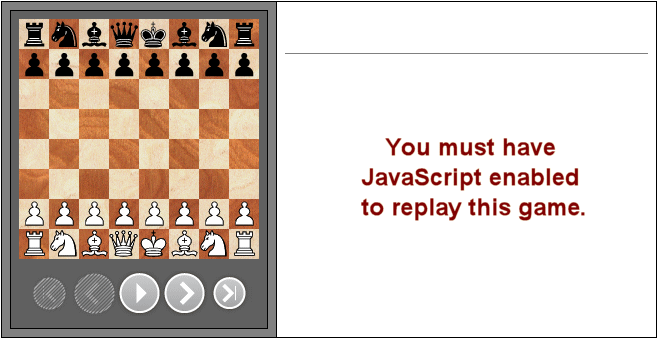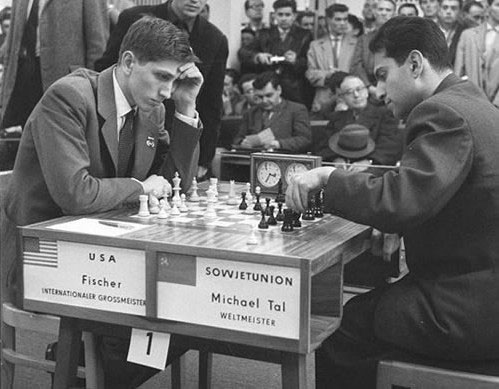



After the world chess champion Magnus Carlsen collected two more world titles last week in Dubai, winning the FIDE Rapid and Blitz championships, new comparisons were inevitable. Now he might be compared to a horse or a long distance runner, I thought.
The famous horse I had in mind was Secretariat, one of the best thoroughbreds of the last century, having swept the Triple Crown – the Kentucky Derby, the Preakness Stakes and the Belmont Stakes – in record times in 1973. The long-distance runner was Emil Zátopek, winning three gold medals at the 1952 Helsinki Olympic Games, in the 5 km and 10 km races, and the marathon.
Carlsen evoked comparisons from an early age. In January 2004 in the Washington Post, I called the 13-year-old Carlsen the Mozart of Chess for the splendid finish of his game against Sipke Ernest at the Corus tournament in Wijk aan Zee.

[Event "Corus C"] [Site "Wijk aan Zee NED"] [Date "2004.??.??"] [Round "?"] [White "Carlsen, Magnus"] [Black "Ernst, Sipke"] [Result "1-0"] [WhiteElo "2484"] [BlackElo "2474"] [Annotator "GM Lubomir Kavalek/The Huffington Post"] [SetUp "1"] [FEN "3r1rnk/pp2b1p1/4Q1Pp/q1p5/3P1B2/8/PPP2PP1/1K1R3R w - - 0 21"] [PlyCount "17"] [EventDate "2004.01.10"] [EventType "tourn"] [EventRounds "13"] [EventCountry "NED"] [EventCategory "9"] [WhiteClock "1:05:00"] [BlackClock "1:11:00"] 21. Bxh6 $1 gxh6 22. Rxh6+ $3 {This gorgeous rook sacrifice opens the h-file and is based on a vulnerable seventh rank.} Nxh6 23. Qxe7 Nf7 {(The only reasonable way to defend against 24.Qh7 mate.)} 24. gxf7 $1 ({Creating a mating attack. Carlsen's move improves on the game Almagro Llanas,P (2375) -Gustafsson,J (2570), Madrid 2003, in which after} 24. Qf6+ Kg8 25. Rh1 Nh6 26. Qe7 Nf7 {but after} 27. Qf6 ({White still wins with} 27. Rh5 $1 Kg7 28. gxf7 Qa6 29. Qe5+ Qf6 30. Qg3+ Qg6 (30... Kxf7 31. Qc7+ Ke6 32. Re5+ $18) 31. Rg5 $18) 27... Nh6 28. Qe7 Nf7 {a draw was agreed.}) 24... Kg7 ({After} 24... Qb6 25. Qe5+ $1 Kh7 26. Rh1+ Qh6 27. Rxh6+ Kxh6 28. Qf6+ {white wins, for example} Kh7 (28... Kh5 29. f3) 29. c3 $1 cxd4 30. g4 d3 31. g5 d2 32. Qh6#) 25. Rd3 ({ A good way to win, but better is} 25. Qe5+ $1 Kxf7 26. Rd3 {for example:} Rxd4 (26... Rg8 27. Rf3+ Kg6 28. Qf6+ Kh5 29. Rh3+ Kg4 30. f3#) 27. Rf3+ Kg6 28. Rg3+ Kh6 29. Qg7+ Kh5 30. Qh7#) 25... Rd6 $2 ({Allowing a nice mate. Black could have prolonged the game with} 25... Qb6 {but white should win after} 26. Rg3+ Qg6 27. Rxg6+ Kxg6 28. d5 $18) 26. Rg3+ Rg6 27. Qe5+ Kxf7 (27... Kh7 28. Qh5+ Rh6 29. Qf5+ Kh8 30. Qe5+ Kh7 31. Qg7#) 28. Qf5+ Rf6 ({After} 28... Ke7 29. Re3+ {wins. Now the game ends with an epaulet mate.}) 29. Qd7# 1-0
With a conclusion like this Magnus was soon being compared to Mikhail Tal, the most imaginative world champion.
In 1956, two magnificent players appeared on the chess horizon: the 13-year-old Bobby Fischer created "the game of the century" against Donald Byrne at the U.S. Championship in New York and Tal played a dramatic, nail-biting game against Alexander Tolush in the last round of the Soviet Championship in Leningrad. Next year, both Fischer and Tal won the championships of their countries for the first time. In 1960 Tal became the world champion.

Several commentators, including Garry Kasparov, tried to dissect the amazing Tal-Tolush game with the help of the computers, but even the machines were confused by the wild play and showed different solutions.

[Event "URS-ch23"] [Site "Leningrad"] [Date "1956.??.??"] [Round "?"] [White "Tal, Mihail"] [Black "Tolush, Alexander V"] [Result "1-0"] [Annotator "GM Lubomir Kavalek/The Huffington Post"] [SetUp "1"] [FEN "rnb1kb1r/1p1n3p/4pp2/1N4B1/q3N3/1R6/2PQ1KPP/7R w kq - 0 18"] [PlyCount "27"] [EventDate "1956.01.10"] [EventType "tourn"] [EventRounds "17"] [EventCountry "URS"] {The Poisoned Pawn variation in the Najdorf Sicilian began to appear in important tournaments at that time and Tal contested the line with great energy, aiming to develop quickly, disregarding the material. He was a bishop down when he brought the last piece into play.} 18. Re1 $1 ({After} 18. Nxf6+ Nxf6 19. Bxf6 Bc5+ {black gets out of trouble.}) 18... Ra6 (18... Nc6 19. Bxf6 Qxe4 20. Nc7+ Kf7 21. Bxh8 $1 $16) (18... fxg5 19. Nc7+ Kd8 20. Nxe6+ Ke8 21. Ng7+ $3 Bxg7 22. Nd6+ Kd8 23. Nf7+ Kc7 24. Qd6#) 19. Bxf6 Nxf6 20. Nxf6+ Kf7 21. Rf3 ({The rook-move wins, too, but Tal could have played more forcefully:} 21. Ne4 Rg8 (21... Nd7 22. Qg5 $1 $18) 22. Qf4+ Ke8 23. Nbd6+ Bxd6 24. Nxd6+ Kd8 25. Qf6+ Kd7 26. Nb5 {threatening deadly rook checks on the d-file.}) ({Or even the entertaining} 21. Qg5 Rc6 22. Nd5 $1 $18 {is possible, when everything hangs, but white wins.}) 21... Qh4+ (21... Qxb5 22. Nd5+ Ke8 23. Nc7+ {wins.}) ({After} 21... Bc5+ 22. Kg3 {white preserves all threats.}) 22. Kf1 e5 23. Qd5+ ({The computers suggested:} 23. Nh5+ $1 Kg6 24. Rg3+ Bg4 25. h3 $1 {and the black king cannot escape.}) 23... Be6 24. Nd7+ ({Here again} 24. Nh5+ {should win for white, for example:} Kg6 25. Qxe5 Nd7 26. Rg3+ Bg4 27. Qxh8 $18) 24... Kg6 $2 {Losing.} (24... Ke7 $1 {would make the win much harder. }) 25. Nxe5+ Kg7 ({After} 25... Kh5 {white wins with} 26. g4+ (26. Qd1 $1 {is also possible.}) 26... Qxg4 27. Qd3 $1 $18) 26. Rg3+ $1 Qxg3 (26... Kh6 27. Nf7+ Bxf7 28. Qd2+ Kh5 29. Re5+ {mates.}) (26... Kf6 27. Qd8+ Be7 28. Qxh8+ $18 ) 27. Qxb7+ Nd7 28. hxg3 Rb6 29. Qc7 Bc5 30. Nxd7 Bc4+ 31. Re2 {and Black overstepped the time limit.} 1-0
I saw the power of Tal's imagination in the Dutch town of Eersel in 1969. Misha played Bent Larsen for the right to be the first reserve in the upcoming Candidates matches. While my ten-game match against the Dutch champion Hans Ree was going rather well (and I eventually won 7-3), Tal was losing to Larsen.
No matter how the matches were going, we would often meet with Misha after the games in the hotel pub filled with smoke from cheap cigars and talk about chess. One evening I was showing him a King's Gambit game I played in Czechoslovakia shortly after he became the world champion. I thought he would be pleased to see how his wonderful rook move 18.Re1 from his game against Tolush was interpreted elsewhere. Not so.
I didn't even reach the key position when Tal suddenly covered the pieces with his hand and said: "Don't tell me what you've played. I know what you did!" And without hesitation, the magician from Riga placed my bishop on a square where it could have been taken by the queen and bishop. It was perhaps not the best move, but it was shocking and surprising.
I showed the position recently to an enthusiastic Czech club player Vaclav Chladek and he came up rather quickly with the same move Tal suggested. But he admitted he was looking for something extraordinary or even ridiculous. Tal's move didn't cross my mind during the game: my brain was seeking something else. The computers later found another bishop sacrifice.

[Event "Trebic, CZ sf"] [Site "?"] [Date "1960.??.??"] [Round "?"] [White "Kavalek, Lubomir"] [Black "Dolezal, Jiri"] [Result "1-0"] [Annotator "GM Lubomir Kavalek/The Huffington Post"] [SetUp "1"] [FEN "r1bqn1Q1/pppp4/6p1/4k3/7b/2N5/PPP4K/R1B5 w - - 0 19"] [PlyCount "15"] [EventDate "1960.??.??"] 19. Qd5+ {I was getting excited, seeing the ideas leading to 22. Re1. White creates a mating net and sets up a delicate finale. But there was something else, something out of this world.} (19. Bg5 $3 {Misha Tal's brilliant suggestion.} Bxg5 (19... Qxg5 20. Qxe8+ (20. Qd5+ Kf6 21. Ne4+ Kg7 22. Nxg5 { wins.}) 20... Qe7 (20... Kf5 21. Rf1+) 21. Re1+ $1 {wins.}) 20. Re1+ Kf5 21. Rxe8 Qf6 (21... Bf4+ 22. Kh3 Qxe8 23. Qxe8 d5 24. Kh4 $16) 22. Rf8 {winning the queen.}) ({Many computer programs proposed the more powerful} 19. Bf4+ $3 { It is the fastest way to bring the rook into play and finish the mating attack. For example:} Kxf4 ({After} 19... Kf5 20. Rf1 {wins.}) 20. Rf1+ Kg4 (20... Kg5 21. Ne4+ Kh5 22. Qh7+ Kg4 23. Qxg6+ Qg5 24. Nxg5 Bxg5 25. Rf5 d5 26. Qxg5#) ( 20... Ke3 21. Qd5 ({or} 21. Qc4) 21... Bf2 22. Qe4+ Kd2 23. Nb1#) 21. Qxg6+ Qg5 22. Rf4+ $1 Kxf4 23. Qe4#) 19... Kf6 20. Bh6 {(Closing the mating net.)} d6 ( 20... g5 21. Bf8 $1 d6 22. Rf1+ Kg6 23. Qf7#) 21. Ne4+ (21. Rf1+ Bf5 22. Bf8 $3 {(Encircling the black king and threatening 23.Ne4 mate.)} Kg5 (22... Qe7 23. Ne4+ $1 Qxe4 24. Qxe4 Kf7 25. Qxh4 Kxf8 26. Re1 $18) 23. Ne4+ Kh5 (23... Kg4 24. Qd1#) 24. Rxf5+ gxf5 25. Qxf5+ Qg5 26. Nxg5 Bxg5 27. Be7 $18) 21... Ke7 22. Re1 $1 {Remembering the game Tal-Tolush, Soviet championship 1956, where the same move was decisive. Misha just smiled.} Bf5 {Other moves lead to white’s advantage or outright win:} (22... Nf6 23. Nxf6+ Kxf6 (23... Bxe1 24. Ng8+ Ke8 25. Bg5 $18) 24. Qf3+ Bf5 25. Qc3+ Kf7 26. Qg7#) (22... Bxe1 23. Bg5+ Kf8 ( 23... Kd7 24. Nc5#) 24. Bxd8 Bf5 25. Ng5 {wins.}) (22... c6 23. Ng5+ Kd7 24. Qf7+ Qe7 25. Qxe7#) (22... Qd7 23. Ng3+ Qe6 24. Rxe6+ Bxe6 25. Qxb7 $16) (22... Be6 23. Nc5 {wins.}) 23. Bg5+ Bxg5 (23... Kf8 24. Bxd8 Rxd8 25. Ng3 $18) 24. Nxd6+ Be3 (24... Kd7 25. Nxb7+ Nd6 (25... Kc8 26. Nxd8 $18) 26. Nc5+ Kc8 27. Qxa8#) 25. Rxe3+ Kf6 26. Qe5+ (26. Qe5+ Kg5 27. Rg3+ Kh6 28. Qh8#) 1-0
I was visiting Boris Spassky in Paris when we learned the sad news that Misha Tal died on Sunday, June 28, 1992. Twenty-two years later Tal's name and his creations are as popular as ever.
Quality Chess launched a trilogy Mikhail Tal's Best Games, written by the Hungarian IM Tibor Karolyi. The first volume The Magic of Youth covers Tal's play from 1949 till 1959. The author selected great games, scrutinized them with computers and delivered new comments. He also sought input from Tal's opponents, friends and coaches, creating a vivid picture of Tal as a person. Among many books written about Tal, Karolyi's work is stands out.
Carlsen's image by Anastasiya Karlovich
Original column here – Copyright Huffington Post
The Huffington Post is an American news website and aggregated blog founded by Arianna Huffington and others, featuring various news sources and columnists. The site was launched on May 9, 2005, as a commentary outlet and liberal/progressive alternative to conservative news websites. It offers coverage of politics, media, business, entertainment, living, style, the green movement, world news, and comedy. It is a top destination for news, blogs, and original content. The Huffington Post has an active community, with over over a quarter of a billion visits per month (according to Quantcast), making it the number 73 ranked web site in the world (Alexa, January 2014)..